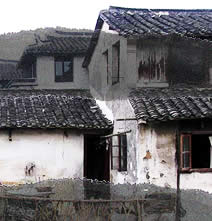|
Its long history, rich cultural tradition and unique natural environment have given Zhouzhuang a distinctive flavor. The local accent, dress and social customs reveal a certain rustic yet simple elegance.
1. Traditional fashion
A local woman's traditional dress features a flowery towel (or a piece of blue cotton) for a scarf, a right-buttoned jacket, a short pleated apron around her waist, a pair of black pants, and a pair of embroidered shoes on her feet. The apron is secured with two colorful laces, the ends of which hang down to her knees.
However, as with most cities and towns in China that have had a brush with urbanization, one would be hard pressed to find many women in their traditional dress, particularly the younger ladies.
2. "Grandma Tea"
“Grandma Tea” is a special Zhouzhuang tea party, where men and women, young and old, chitchat over tea and pastries. Local folk, especially the older people, are extremely particular about how their tea is prepared. The secret to their tea is rainwater. Rainwater is collected in vats and later boiled in earthenware jars over a wood stove. The tea is brewed with just a liter of water in lidded cups or in dark brown clay teapot before it is diluted and served. Zhouzhuang folk believe that this is the only way to savor the full flavor of tea.
3. Boat races
Boat racing is a popular way of celebrating festivals, good harvests and weddings in Zhouzhuang. It's a tradition that has endured since the 17th century.
Before a race, craftsmen are hired to construct a brightly colored, at times gaudy, tent with silk and satin curtains. A gong and drum band sits inside the tent. Each boat also sits 16 rowers, dressed in embroidered suits and woven straw slippers.
Whenever there is a cause for celebration, boats from nearby villages join in the festivities, which are lively and noisy affairs. These days, boat races are also organized for the benefit of tourists.
4. Flower-basket dance
The flower-basket dance is an art form in Zhouzhuang. Women dressed in colorful costumes sing and dance to music played on traditional stringed and woodwind instruments in celebration of a good harvest or as a prayer for peace.
5. Xuanjuan – accompanied ballad singing
Xuanjuan is a folk art form where ballads are sung to traditional music. The performers sing and talk in the Suzhou dialect. Either a band or a lone muyu – a hollow wooden block – provides the music accompaniment. A band usually consists of an erhu – double-stringed Chinese violin, a sanxian – a three-stringed Chinese guitar, a Chinese flute, a muyu, and the qing – a traditional percussion instrument made of brass bars. The xuanjuan melody fuses that of the classic kunqu, the folk song Four Seasons, and Shanghai and Wuxi operas. This 200-year-old art form originated in Zhouzhuang and later spread to neighboring areas including Jinxi, Luzhi, Tongli and Qingpu.
|







